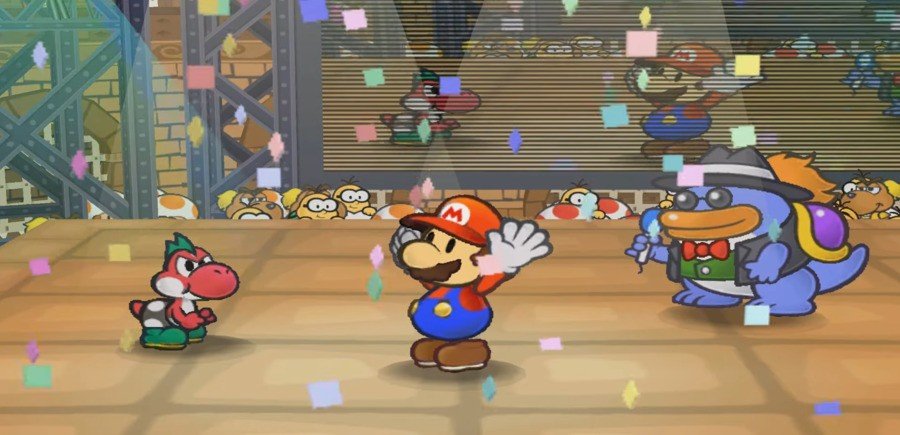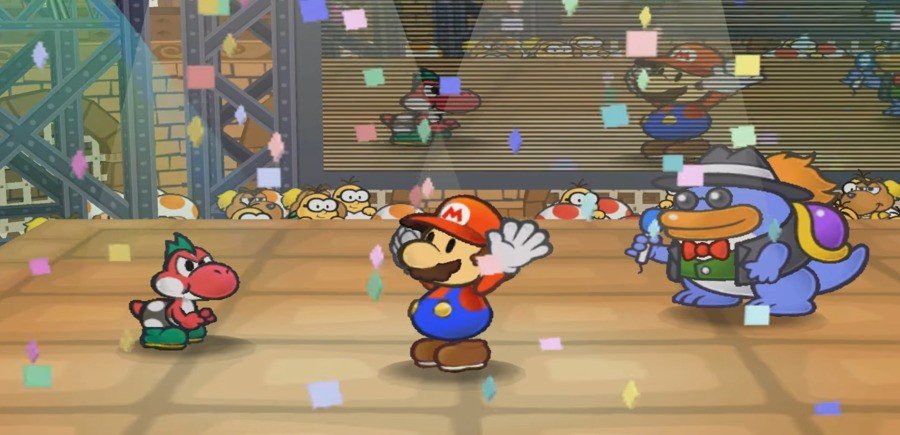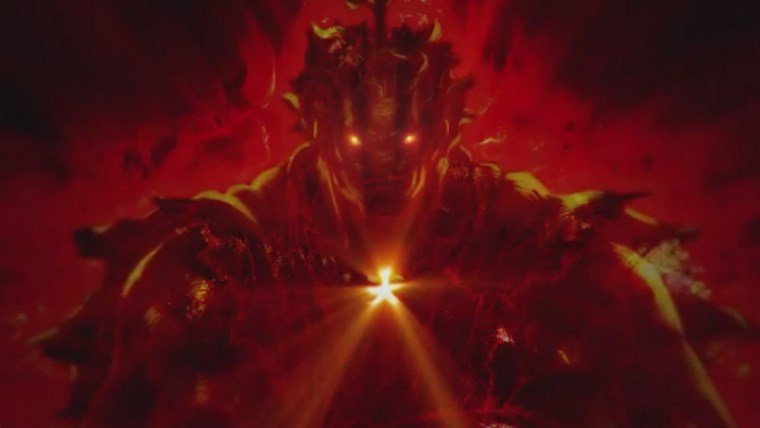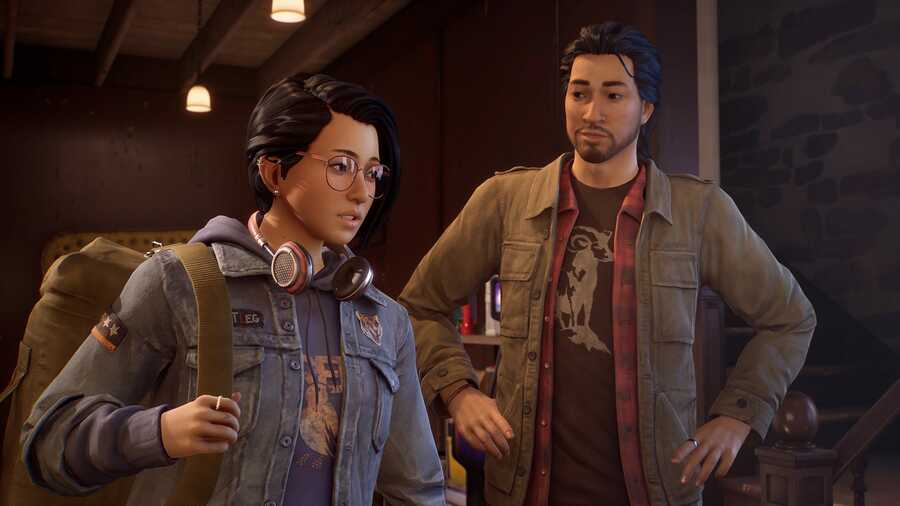

Welcome to the latest instalment in our new-ish column, Memory Pak, where we're going to be doing a deep-dive into some of the most memorable moments in gaming – good and bad. This time, Kate wrestles with some extremely strong feelings for Paper Mario…
I may be bending the rules of Memory Pak slightly by picking an entire chapter of Paper Mario: The Thousand-Year Door, but it's fine, I make the rules here. And this chapter — the third one in the story — is one of the best in the game. Well, most of the chapters are the best. Except the Boggly Tree one. We do not speak of the Boggly Tree.
At the end of Chapter Two, Paper Mario — who is a different entity from Mario, by the way, as canonically confirmed by Mario & Luigi: Paper Jam — is forced to befriend the mafioso, Don Pianta, in order to get a ticket on a blimp to take him to Glitzville, a sky-island packed with tourists, shady weirdos, and the Glitz Pit.
Paper Mario and his companion enter the Glitz Pit to find that it is the main hub of activity in Glitzville: a wrestling ring, ruled over by wrestling champ and massive egomaniac, Rawk Hawk. And on the championship belt: The Crystal Star! That's what Paper Mario needs to open the Thousand-Year Door!!
There's only one solution: approach Rawk Hawk and ask nicely for the Crystal Star, please and thank you. Well, that's what a sensible person would do — Paper Mario instead marches into the manager's office and demands to be the next wrestler on his rota. And thank Triple H he did, because what follows is some incredible storytelling.
There is a trope in episodic TV called a "bottle episode", in which — either because of financial or creative constraints — the characters largely stay in one place. You may have heard about it from Community, in which the characters (well, Abed) are constantly lampshading their own TV-ness, or you may have noticed that some sitcom episodes take place in an elevator, an apartment, a spaceship, and so on.
Despite the fact that these episodes arise from wanting to save money, they often become the most memorable and well-loved episodes of the show in its entirety, because bottle episodes have to rely on really, really solid writing in order to stand up on their own.
Glitzville is one such bottle episode, as it's largely set in the Glitz Pit, following Paper Mario's rise to wrestlefame. Like many bottle episodes before it, the dialogue is pumped up to 11, and given that Paper Mario: TTYD's writing is already stellar, that's saying something.
In the ring, our 2D hero is no longer Paper Mario — he is The Great Gonzales, an up-and-comer who begins right at the bottom of the table, fighting Fuzzies and Goombas to rise up the ranks. The fantastic thing is that these mooks aren't just random chaps in the field anymore; they're all wrestling teams, fighting you not for Bowser's sake, but because it's ENTERTAINMENT, dangit. They all have wrestler names, like Cleftor, Sir Swoop, and Spiky Joe, and fightin' catchphrases that they yell at Gonzales, just like real wrestling.
If you follow the story and don't get distracted along the way, most of the story is just The Great Gonzales doing a battle, taking a break, then immediately doing another battle. It could be boring, but Paper Mario's battle system is engagingly theatrical and constantly surprising, despite its two-dimensional limitations. It's a testament to how strong a combat system it is that the third chapter in the game — when Mario has very few special abilities and companions — is entirely based around it without ever seeming threadbare.
But the downtime between matches slowly gets to be just as compelling, if not more. After swiftly kicking these chumps to the curb, Gonzales returns to the locker rooms; you can talk to the other wrestlers in here (the chumps you just kicked) to make friends, making it clear that they're only interested in punching you when it's wrestletime.
The whole time, you're having to deal with Grubba — a shady wrestling manager who definitely has some darker motives — and his assistant, Jolene, a Toad/girlboss. The characterisation in TTYD is fantastic in every single area, and Glitzville is a great example, because of the density of new characters in one place. Rawk Hawk is a macho tough guy bully; the newly-hatched companion is small, feisty, and capable of holding his own against guys four times his size; the mysterious whistleblower, "X", is a secret benefactor who lavishes Paper Mario with gifts in an attempt to reveal the conspiracy at the heart of the Glitz Pit.
For every match, you'll be expected to stick to a specific request — don't switch out your partners, or make sure to use only the hammer — and if you fail, you won't get moved up to the next rank. You'll also start receiving mysterious, anonymous whistleblower emails, and at one point, an egg appears, which will later hatch into a brand-new companion.
After a few matches, Gonzales gets upgraded to the Major League locker room, a significantly nicer place that probably doesn't smell like stale sweat and cheap deodorant. The whistleblower emails get more and more frequent, and intriguing — it might not smell like stale sweat, but it definitely smells like some kind of scheme.
The Glitzville chapter is a fantastically-told story of dishonest shysters, fragile egos, and plucky underdogs; it sets up Paper Mario and his companions as a troupe who'll do the right thing, but aren't afraid to have a bit of fun while doing it. The central mystery is compelling and well-paced, and the battles that Gonzales has to do in order to get his papery mitts on the Crystal Star manage to never get old. Grubba's match requests and the rising difficulty curve keep things feeling plenty fresh, and there's always the promise of the Crystal Star at the end of it all to keep you going.
I haven't really mentioned real wrestling much in this Memory Pak, mostly because I don't know too much about it, but from what I have watched, it feels like the Glitz Pit nails a lot of the best parts of the sport. Wrestling is goofy, thrilling, and doesn't take itself too seriously; you're as likely to see a beefy chap in a leotard piledrivering another beefy chap in a different leotard as you are to see a wrestler jumping out of a giant cake during an in-the-ring wedding.
Wrestling is a soap opera led by people made of muscle and glitter, and what could be more soap opera than a ringside conspiracy involving missing fighters, mysteriously muscular managers, and rumours of a haunted toilet? The Glitz Pit is a perfect bottle chapter for both wrestling fans and novices alike, because it takes something players know well — Paper Mario's combat system — and repackages it into something novel. Add a dash of Paper Mario-style goofs, a mystery worth unravelling, and the series' trademark witty dialogue, and you've got one of the best adventures in all of games.


